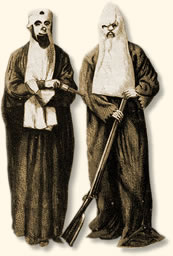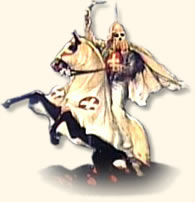|
The Ku Klux Klan, 1868
Its very name struck terror in the hearts
of its victims. However, the beginning of the Ku Klux Klan was innocent enough.
In December 1865, eight months after the South’s surrender, a group of
six young men living in the village of Pulaski near Nashville, Tennessee decided
to relieve their boredom by organizing a social club. All were veterans of the
Confederate Army and some had attended college where fraternities with three-letter,
Greek-based names were popular. In mock-imitation, they came up with the alliterative
title Ku Klux Klan for their group. Their meetings would be secret and devoted
to elaborate ceremonies. Members would disguise themselves with a costume
made up of a sheet to cover their bodies, fanciful masks to hide their faces
and pointed headgear that heightened their stature. Their leader would be known
as the Grand Cyclops.
 |
Two Army officers pose
in KKK costumes captured in
a raid in Alabama, 1868 |
Although their motives may have been innocent, the appearance of these white-sheeted,
horse-mounted apparitions on the town’s darkened streets triggered a
panic-driven flight for safety by the community’s recently freed slaves.
Soon, terrorizing Blacks became a prime sport and the transition of the KKK
from an innocuous social club to a ruthless vigilance committee began.
Transmitted by word-of-mouth and newspaper articles; knowledge of the Klan
rapidly spread through the South. Post-war conditions in the former Confederacy
were chaotic. The rapid expansion of the Klan was fueled by a wide-spread fear
among many Southern Whites of an insurrection by former slaves and seething
resentment against Northern “carpet-baggers” who had invaded the
South since the end of the war. Local organizations mimicking the original
group’s secrecy and costumes sprang up in various communities. It wasn’t
long before the Klan evolved into one of the South’s most powerful organizations.
However, there was no hierarchal chain of command – merely a loose-knit
association of independent local groups that shared common goals and tactics.
Former slaves and carpet-baggers were favorite targets for intimidation backed
up by violent night-time raids that could end in death.
The KKK’s reign was short-lived, its decline hastened by the revulsion
of many southerners to its extreme methods and
suppression by local governments. By 1868, its power was beginning to wane.
In 1871 Congress passed the Klu Klux Klan Act that authorized the use of federal
troops in the Klan’s suppression and for the trial of its members in federal court. The Klan melted
away, or a least did not make any further public appearances until its revival in 1915.
Ben Johnson was born a slave around 1848. Eighty-five years later he was interviewed by a team from the Federal Writers' Project that was gathering recollections from former slaves. We join him and his wife as they sit on the front porch of their home near Durham, NC and he recalls his encounters with the Ku Klux Klan shortly after the end of the Civil War:
“I was born in Orange County [North Carolina] and
I belong to Mr. Glibert Gregg near Hillsboro. I don’t know nothin’ ‘bout
my mammy and daddy, but I had a brother Jim who was sold to dress young misses
fer her weddin’. The tree is still standing where I set under an’ watch
them sell Jim. I set dar an’ I cry an’ cry, especially when they
puts the chains on him an’ carries him off, an’ I ain’t never
felt so lonesome in my whole life. I ain’t never hear from Jim since an’ I
wonder now sometimes if’en he’s still living.
I knows that the master was good to us an’ he fed an’ clothed us
good. We had our own garden an’ we was gitten’ long all right.
I seed a whole heap of Yankees when they comed to Hillsboro an’ most of
them ain’t got no respect for God, man, nor the devil. I can’t remember
so much about them though cause we lives in town... an’ we has a gyard.
The most that I can tell you ‘bout is the Klu Klux. I never will forget
when they hung Cy Guy. They hung him for a scandalous insult to a white woman
an’ they comed after him a hundred strong.
They tries him there in the woods, an’ they scratches Cy’s arm
to get some blood, an’ with that blood they writes that he shall hang ‘tween
the heavens and the earth till he is dead, dead, dead, and that any nigger
what takes down the body shall be hanged too.
Well sir, the next morning there he hung, right over the road an’ the sentence
hanging over his head. Nobody would bother with that body for four days an’ there
it hung, swinging in the wind, but the fourth day the sheriff comes an’ takes
it down.
There was Ed an’ Cindy, who before the war belonged to Mr Lynch an’ after
the war he told them to move. He gives them a month and they ain’t gone,
so the Ku Kluxes gets them.
 |
An image from a poster advertising
the 1915 film Birth of a Nation.
The film was an important
contributor to the
Klan's revival that year. |
It was on a cold night when they came and dragged the niggers out of bed. They
carried them down in the woods an’ whup them, then they throes them in
the pond, their bodies breakin’ the ice. Ed comes out an’ come to
our house, but Cindy ain’t been seen since.
Sam Allen in Caswell County was told to move an’ after a month the hundred
Ku Klux came a-totin’ his casket an’ they tells him that his time
has come an’ if he wants to tell his wife goodbye an’ say his prayers;
hurry up.
They set the coffin on two chairs an’ Sam kisses his old woman who’s
a-crying, then he kneels down beside his bed with his head on the pillar an’ his
arms thrown out in front of him.
He sits there for a minute an’ when he rose he had a long knife in his
hand. Before he could be grabbed, he done kill two of the Klu Kluxes with the
knife, an’ he done gone out of the door. They ain’t catch him neither,
and the next night when they came back, determined to get him, they shot another
nigger by accident.
Bob Boylan falls in love with another woman, so he burns his wife an’ four
youngsters up in their house.
The Ku Kluxes gets him, of course, an’ they hangs him high on the old red
oak on the Hillsboro Road, After they hanged him, his lawyer says to us boys: ‘Bury
him good, boys, just as good as you’d bury me if I was daid’
I shook hands with Bob before they hanged him an’ I helped bury him too
an’ we bury him nice an’ we all hopes that he done gone to glory."
References:
This eyewitness account is a part of the collection of the
Library of Congress: WPA Slave Narrative Project, North Carolina Narratives,
Volume 11, Part 2, Federal Writer's Project, United States Work Projects Administration
(USWPA); Manuscript Division, Library of Congress; Chalmers, David Mark, Hooded
Americanism: the history of the Ku Klux Klan (1981); Horn, Stanley, F. Invisible
Empire: the story of the Ku Klux Klan, 1866-1871 (1969).
How To Cite This Article:
"The Ku Klux Klan, 1868", EyeWitness to History, www.eyewitnesstohistory.com
(2006).
| 





